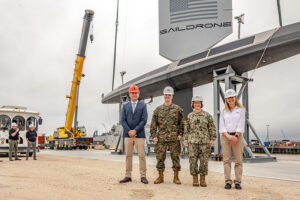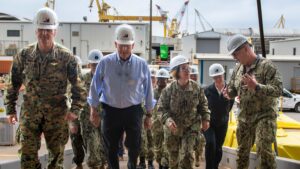Saildrone and Austal USA launched the first aluminum Surveyor unmanned surface vehicle on Wednesday off the latter’s new production line.
The two companies first announced a
partnership for Austal’s Mobile, Ala., aluminum production line to become the exclusive builder of the Surveyor in 2022 (Defense Daily, Aug. 30, 2022).
The 65-foot-long Surveyor is designed to primarily perform deep ocean mapping and maritime domain awareness missions. The vessel is powered by wind, solar and a diesel generator for long-range and long-endurance missions on the open ocean.

Saildrone highlighted the vehicle’s newest multibeam sonar equipment can perform seafloor mapping at depths up to 36,000 feet down. It can also carry “purpose-built defense and security payloads for accurate, dynamic, and confident decisions and responses to the full spectrum of maritime threats and challenges.”
The company said upcoming Navy missions for Surveyor will have it provide both surface and undersea intelligence, including for anti-submarine warfare.
The companies said Austal is building one Surveyor every six weeks, but can scale up production to a faster rate if needed. This first vehicle is labeled SD-3000.
In December, Saildrone said at the time it was building one Surveyor per month, on average, before this first Austal vehicle was finished (Defense Daily, Dec. 20, 2023).
Chief of Naval Operations (CNO) Adm. Lisa Franchetti and Assistant Commandant of the Marine Corps (ACMC) Gen. Christopher Mahoney inspected the vehicle while visiting the shipyard on March 4.
During the trip they also visited nearby Bollinger Mississippi Shipbuilding and HII’s [HII] Ingalls Shipbuilding in Pascagoula, Miss. This was their first combined visit to see the Navy’s shipbuilding industry in the region.
“It is tremendous to see the first vehicle launched of many that will be produced here in Alabama. We are honored to have Admiral Franchetti here in person to witness the start of the creation of a new fleet of USVs alongside traditional manned ships. Everyone at Saildrone is very proud to be supporting the U.S. Navy and contributing to our defense and national security,” Saildrone founder and CEO Richard Jenkins, said in a statement.
During her visit, Franchetti reiterated her view that “using unmanned assets helps put more players on the field by freeing up manned assets for more specific and important tasks.”
“It’s good to see high tech industry partnering with the traditional shipbuilding industrial base to rapidly deliver cutting-edge products at scale,” she added.

Franchetti and Mahoney were joined by program Executive Officer for Ships Rear Adm. Tom Anderson and Roger Wicker (R-Miss), ranking member of the Senate Armed Services Committee. At Austal they were also joined by Rep. Jerry Carl (R-Ala.).
Mahoney agreed on the importance of getting “more players on the field,” in a statement at the shipyard.
“We are at the brink of a new battlefield where uncrewed systems, at scale, will provide new levels of resilience and adaptability for our forces. Integrating Marines, Amphibious Warfare Ships, and Medium Landing Ships into that equation opens up some great advantages in competition and conflict. I join the CNO in advocating for continued integration between our two services and the joint force to optimize manned-unmanned teaming,” he said.
During their visit to Ingalls Shipbuilding in Pascagoula, the CNO and ACMC toured the future USS Richard M. McCool Jr. (LPD-29) San Antonio-class amphibious transport dock and Bougainville (LHA-8) America-class amphibious assault ship.
They also saw progress on production of the future Flight II Arleigh Burke-class destroyer Ted Stevens (DDG-128) and USS Zumwalt (DDG-1000), which is undergoing upgrades to field hypersonic missiles.
“This is the future right here. DDG-1000, with technology upgrades including the integration of the Conventional Prompt Strike weapon system, is quite an engineering feat and ensures Zumwalt remains one of the most technologically advanced and lethal ships in the U.S. Navy,” she said.